Principles of Business Communication and Information Report Analysis
VerifiedAdded on 2020/06/04
|9
|1439
|210
Report
AI Summary
This report analyzes the principles of business communication, covering key areas such as negotiation, presentation techniques, and bespoke documents. It explores the importance of negotiation in a business environment, different approaches, and essential tactics. The report also examines various types of presentations, resources for development, and best practices for delivery. Furthermore, it discusses bespoke documents, including their characteristics, creation factors, and approval processes. Finally, the report delves into information systems, outlining typical development stages, benefits, limitations, and legal/security requirements. The conclusion summarizes the key takeaways from the report, emphasizing the significance of effective communication in achieving business objectives. The report also includes a comprehensive list of references used in the research.
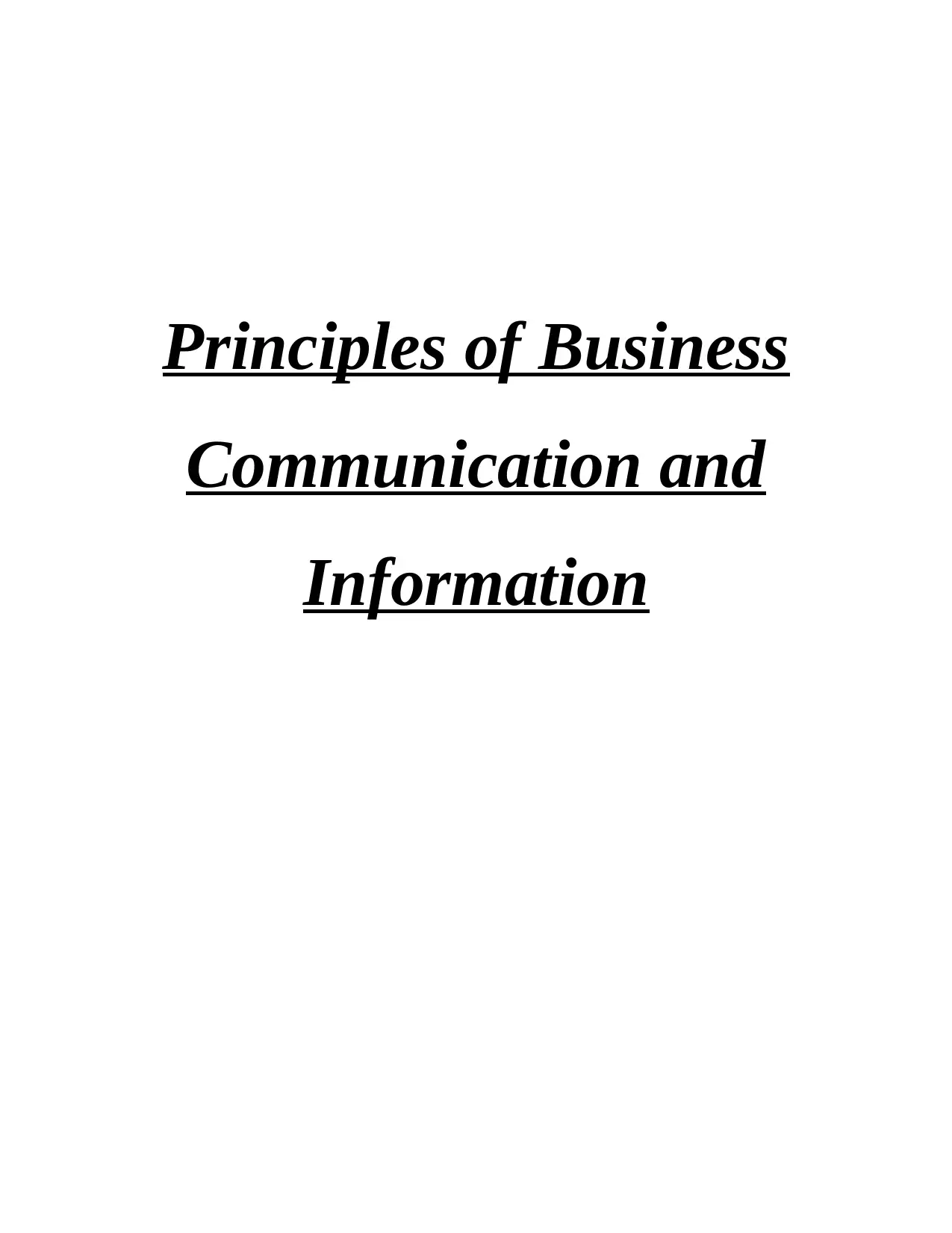
Principles of Business
Communication and
Information
Communication and
Information
Paraphrase This Document
Need a fresh take? Get an instant paraphrase of this document with our AI Paraphraser
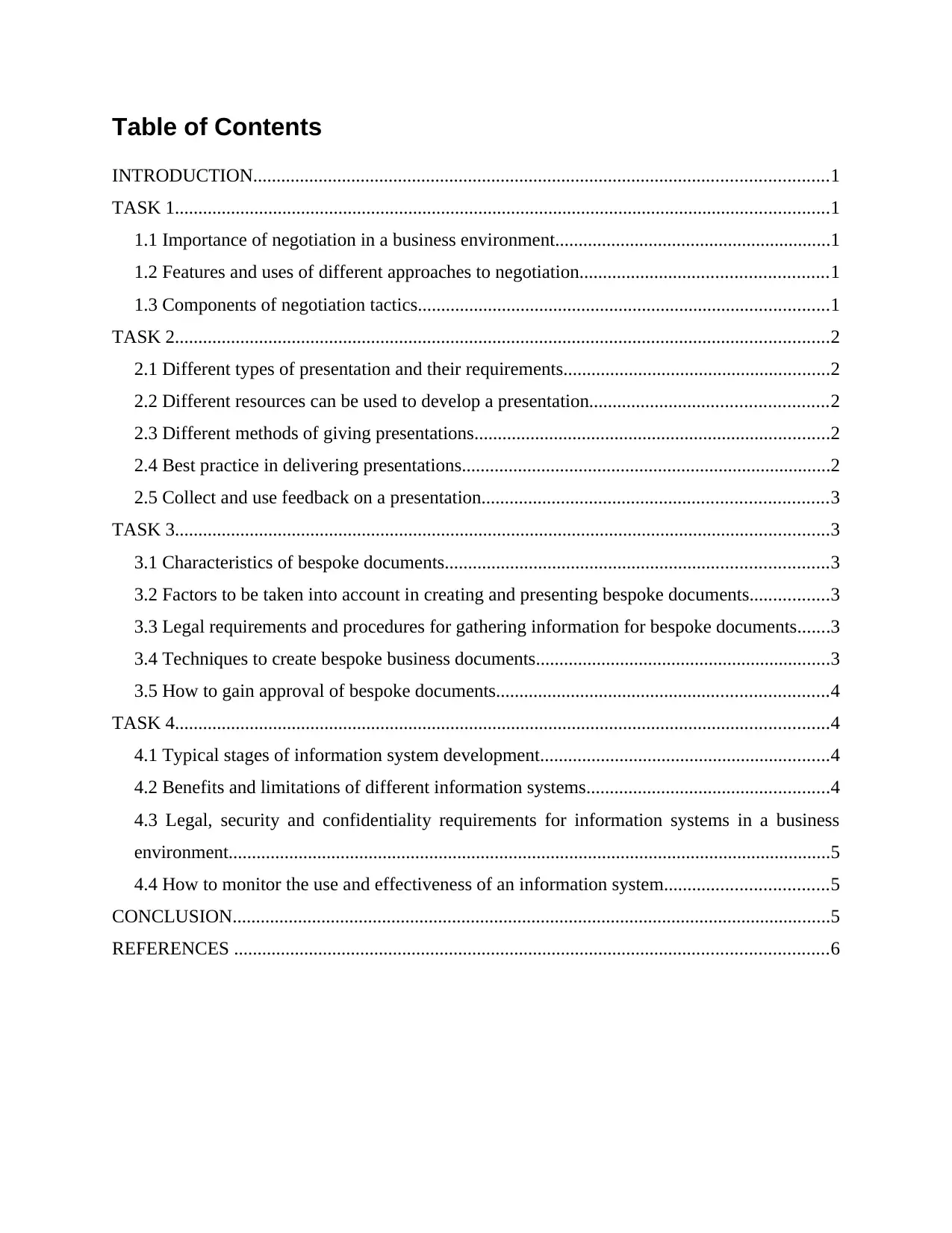
Table of Contents
INTRODUCTION...........................................................................................................................1
TASK 1............................................................................................................................................1
1.1 Importance of negotiation in a business environment...........................................................1
1.2 Features and uses of different approaches to negotiation.....................................................1
1.3 Components of negotiation tactics........................................................................................1
TASK 2............................................................................................................................................2
2.1 Different types of presentation and their requirements.........................................................2
2.2 Different resources can be used to develop a presentation...................................................2
2.3 Different methods of giving presentations............................................................................2
2.4 Best practice in delivering presentations...............................................................................2
2.5 Collect and use feedback on a presentation..........................................................................3
TASK 3............................................................................................................................................3
3.1 Characteristics of bespoke documents..................................................................................3
3.2 Factors to be taken into account in creating and presenting bespoke documents.................3
3.3 Legal requirements and procedures for gathering information for bespoke documents.......3
3.4 Techniques to create bespoke business documents...............................................................3
3.5 How to gain approval of bespoke documents.......................................................................4
TASK 4............................................................................................................................................4
4.1 Typical stages of information system development..............................................................4
4.2 Benefits and limitations of different information systems....................................................4
4.3 Legal, security and confidentiality requirements for information systems in a business
environment.................................................................................................................................5
4.4 How to monitor the use and effectiveness of an information system...................................5
CONCLUSION................................................................................................................................5
REFERENCES ...............................................................................................................................6
INTRODUCTION...........................................................................................................................1
TASK 1............................................................................................................................................1
1.1 Importance of negotiation in a business environment...........................................................1
1.2 Features and uses of different approaches to negotiation.....................................................1
1.3 Components of negotiation tactics........................................................................................1
TASK 2............................................................................................................................................2
2.1 Different types of presentation and their requirements.........................................................2
2.2 Different resources can be used to develop a presentation...................................................2
2.3 Different methods of giving presentations............................................................................2
2.4 Best practice in delivering presentations...............................................................................2
2.5 Collect and use feedback on a presentation..........................................................................3
TASK 3............................................................................................................................................3
3.1 Characteristics of bespoke documents..................................................................................3
3.2 Factors to be taken into account in creating and presenting bespoke documents.................3
3.3 Legal requirements and procedures for gathering information for bespoke documents.......3
3.4 Techniques to create bespoke business documents...............................................................3
3.5 How to gain approval of bespoke documents.......................................................................4
TASK 4............................................................................................................................................4
4.1 Typical stages of information system development..............................................................4
4.2 Benefits and limitations of different information systems....................................................4
4.3 Legal, security and confidentiality requirements for information systems in a business
environment.................................................................................................................................5
4.4 How to monitor the use and effectiveness of an information system...................................5
CONCLUSION................................................................................................................................5
REFERENCES ...............................................................................................................................6
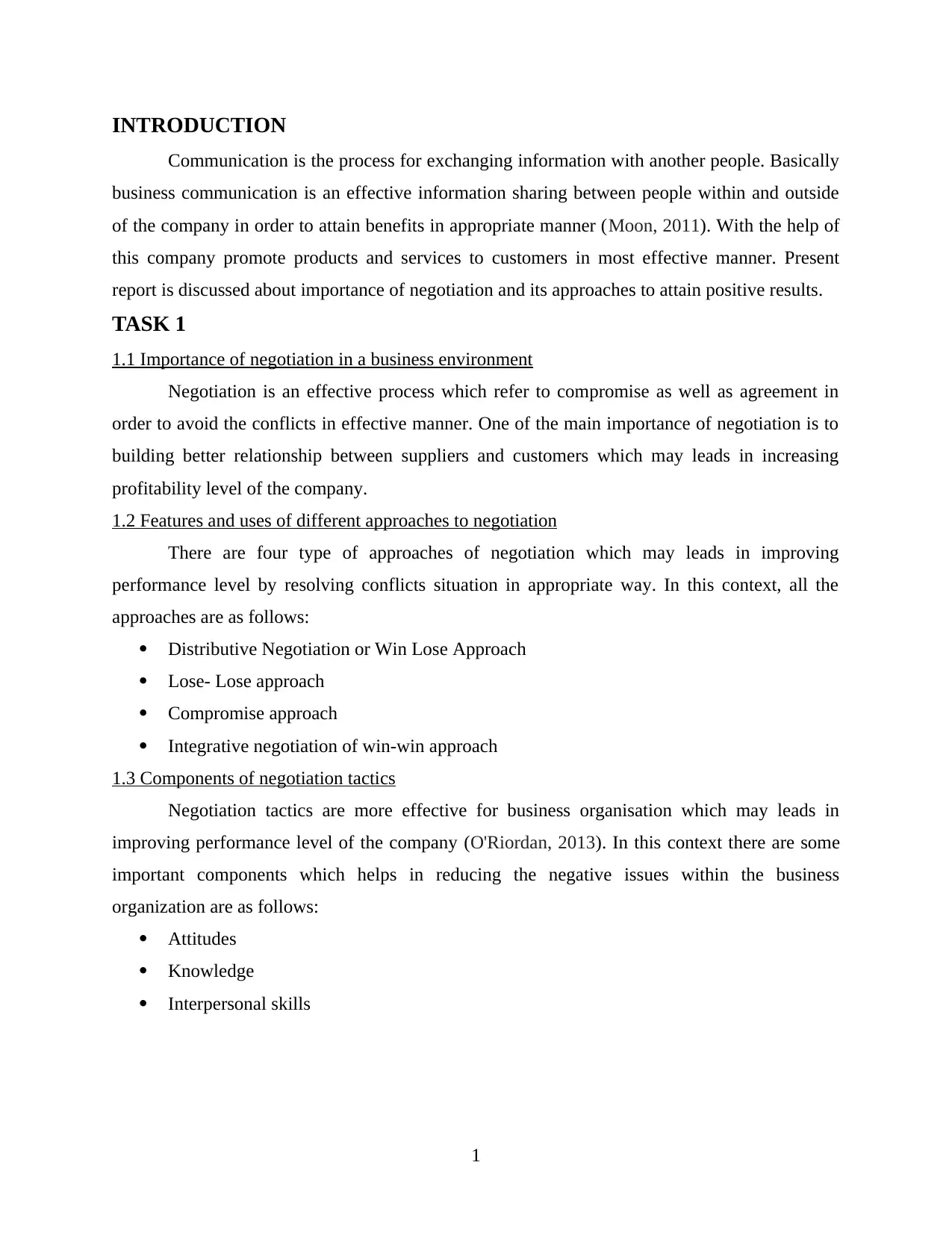
INTRODUCTION
Communication is the process for exchanging information with another people. Basically
business communication is an effective information sharing between people within and outside
of the company in order to attain benefits in appropriate manner (Moon, 2011). With the help of
this company promote products and services to customers in most effective manner. Present
report is discussed about importance of negotiation and its approaches to attain positive results.
TASK 1
1.1 Importance of negotiation in a business environment
Negotiation is an effective process which refer to compromise as well as agreement in
order to avoid the conflicts in effective manner. One of the main importance of negotiation is to
building better relationship between suppliers and customers which may leads in increasing
profitability level of the company.
1.2 Features and uses of different approaches to negotiation
There are four type of approaches of negotiation which may leads in improving
performance level by resolving conflicts situation in appropriate way. In this context, all the
approaches are as follows:
Distributive Negotiation or Win Lose Approach
Lose- Lose approach
Compromise approach
Integrative negotiation of win-win approach
1.3 Components of negotiation tactics
Negotiation tactics are more effective for business organisation which may leads in
improving performance level of the company (O'Riordan, 2013). In this context there are some
important components which helps in reducing the negative issues within the business
organization are as follows:
Attitudes
Knowledge
Interpersonal skills
1
Communication is the process for exchanging information with another people. Basically
business communication is an effective information sharing between people within and outside
of the company in order to attain benefits in appropriate manner (Moon, 2011). With the help of
this company promote products and services to customers in most effective manner. Present
report is discussed about importance of negotiation and its approaches to attain positive results.
TASK 1
1.1 Importance of negotiation in a business environment
Negotiation is an effective process which refer to compromise as well as agreement in
order to avoid the conflicts in effective manner. One of the main importance of negotiation is to
building better relationship between suppliers and customers which may leads in increasing
profitability level of the company.
1.2 Features and uses of different approaches to negotiation
There are four type of approaches of negotiation which may leads in improving
performance level by resolving conflicts situation in appropriate way. In this context, all the
approaches are as follows:
Distributive Negotiation or Win Lose Approach
Lose- Lose approach
Compromise approach
Integrative negotiation of win-win approach
1.3 Components of negotiation tactics
Negotiation tactics are more effective for business organisation which may leads in
improving performance level of the company (O'Riordan, 2013). In this context there are some
important components which helps in reducing the negative issues within the business
organization are as follows:
Attitudes
Knowledge
Interpersonal skills
1
⊘ This is a preview!⊘
Do you want full access?
Subscribe today to unlock all pages.

Trusted by 1+ million students worldwide
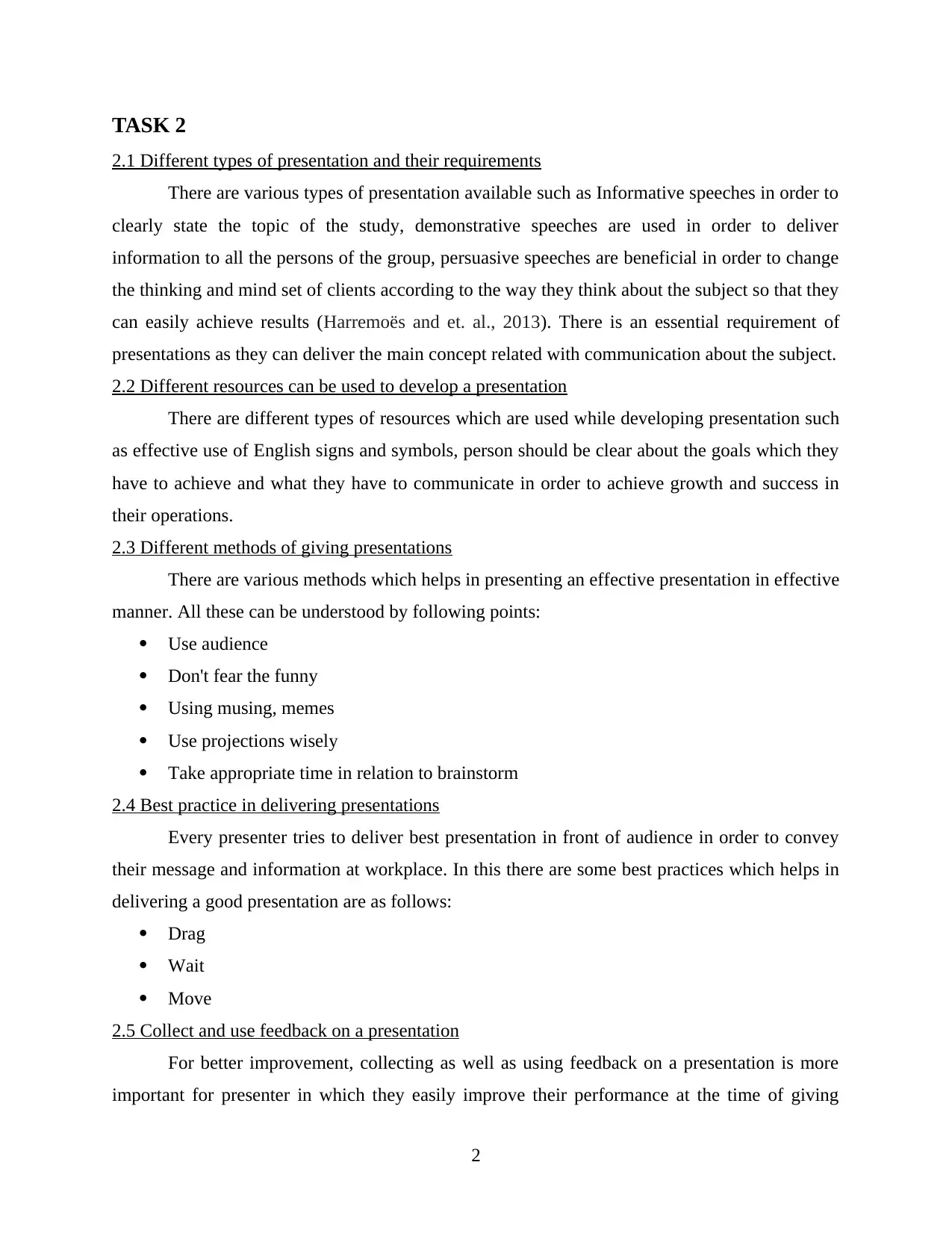
TASK 2
2.1 Different types of presentation and their requirements
There are various types of presentation available such as Informative speeches in order to
clearly state the topic of the study, demonstrative speeches are used in order to deliver
information to all the persons of the group, persuasive speeches are beneficial in order to change
the thinking and mind set of clients according to the way they think about the subject so that they
can easily achieve results (Harremoës and et. al., 2013). There is an essential requirement of
presentations as they can deliver the main concept related with communication about the subject.
2.2 Different resources can be used to develop a presentation
There are different types of resources which are used while developing presentation such
as effective use of English signs and symbols, person should be clear about the goals which they
have to achieve and what they have to communicate in order to achieve growth and success in
their operations.
2.3 Different methods of giving presentations
There are various methods which helps in presenting an effective presentation in effective
manner. All these can be understood by following points:
Use audience
Don't fear the funny
Using musing, memes
Use projections wisely
Take appropriate time in relation to brainstorm
2.4 Best practice in delivering presentations
Every presenter tries to deliver best presentation in front of audience in order to convey
their message and information at workplace. In this there are some best practices which helps in
delivering a good presentation are as follows:
Drag
Wait
Move
2.5 Collect and use feedback on a presentation
For better improvement, collecting as well as using feedback on a presentation is more
important for presenter in which they easily improve their performance at the time of giving
2
2.1 Different types of presentation and their requirements
There are various types of presentation available such as Informative speeches in order to
clearly state the topic of the study, demonstrative speeches are used in order to deliver
information to all the persons of the group, persuasive speeches are beneficial in order to change
the thinking and mind set of clients according to the way they think about the subject so that they
can easily achieve results (Harremoës and et. al., 2013). There is an essential requirement of
presentations as they can deliver the main concept related with communication about the subject.
2.2 Different resources can be used to develop a presentation
There are different types of resources which are used while developing presentation such
as effective use of English signs and symbols, person should be clear about the goals which they
have to achieve and what they have to communicate in order to achieve growth and success in
their operations.
2.3 Different methods of giving presentations
There are various methods which helps in presenting an effective presentation in effective
manner. All these can be understood by following points:
Use audience
Don't fear the funny
Using musing, memes
Use projections wisely
Take appropriate time in relation to brainstorm
2.4 Best practice in delivering presentations
Every presenter tries to deliver best presentation in front of audience in order to convey
their message and information at workplace. In this there are some best practices which helps in
delivering a good presentation are as follows:
Drag
Wait
Move
2.5 Collect and use feedback on a presentation
For better improvement, collecting as well as using feedback on a presentation is more
important for presenter in which they easily improve their performance at the time of giving
2
Paraphrase This Document
Need a fresh take? Get an instant paraphrase of this document with our AI Paraphraser
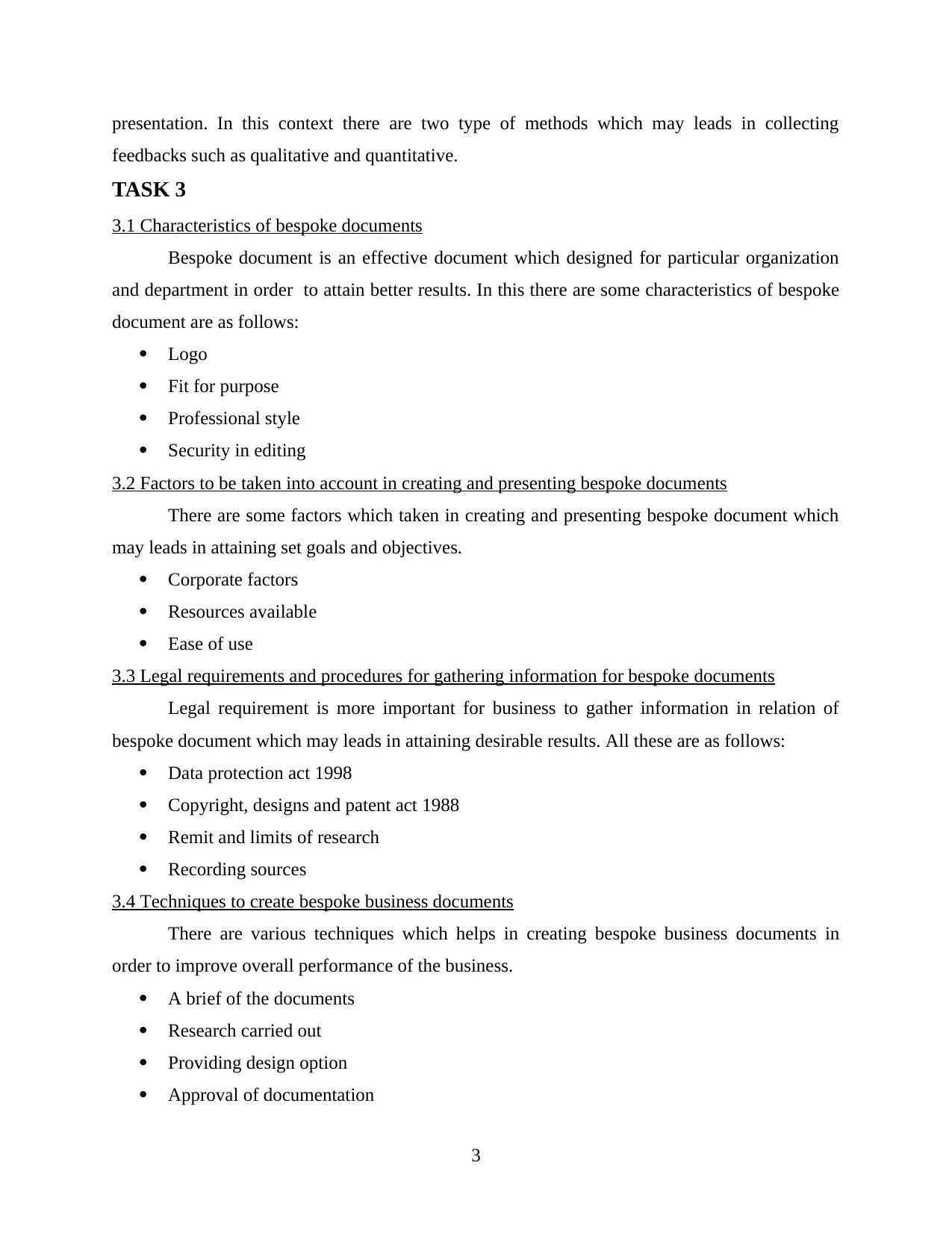
presentation. In this context there are two type of methods which may leads in collecting
feedbacks such as qualitative and quantitative.
TASK 3
3.1 Characteristics of bespoke documents
Bespoke document is an effective document which designed for particular organization
and department in order to attain better results. In this there are some characteristics of bespoke
document are as follows:
Logo
Fit for purpose
Professional style
Security in editing
3.2 Factors to be taken into account in creating and presenting bespoke documents
There are some factors which taken in creating and presenting bespoke document which
may leads in attaining set goals and objectives.
Corporate factors
Resources available
Ease of use
3.3 Legal requirements and procedures for gathering information for bespoke documents
Legal requirement is more important for business to gather information in relation of
bespoke document which may leads in attaining desirable results. All these are as follows:
Data protection act 1998
Copyright, designs and patent act 1988
Remit and limits of research
Recording sources
3.4 Techniques to create bespoke business documents
There are various techniques which helps in creating bespoke business documents in
order to improve overall performance of the business.
A brief of the documents
Research carried out
Providing design option
Approval of documentation
3
feedbacks such as qualitative and quantitative.
TASK 3
3.1 Characteristics of bespoke documents
Bespoke document is an effective document which designed for particular organization
and department in order to attain better results. In this there are some characteristics of bespoke
document are as follows:
Logo
Fit for purpose
Professional style
Security in editing
3.2 Factors to be taken into account in creating and presenting bespoke documents
There are some factors which taken in creating and presenting bespoke document which
may leads in attaining set goals and objectives.
Corporate factors
Resources available
Ease of use
3.3 Legal requirements and procedures for gathering information for bespoke documents
Legal requirement is more important for business to gather information in relation of
bespoke document which may leads in attaining desirable results. All these are as follows:
Data protection act 1998
Copyright, designs and patent act 1988
Remit and limits of research
Recording sources
3.4 Techniques to create bespoke business documents
There are various techniques which helps in creating bespoke business documents in
order to improve overall performance of the business.
A brief of the documents
Research carried out
Providing design option
Approval of documentation
3
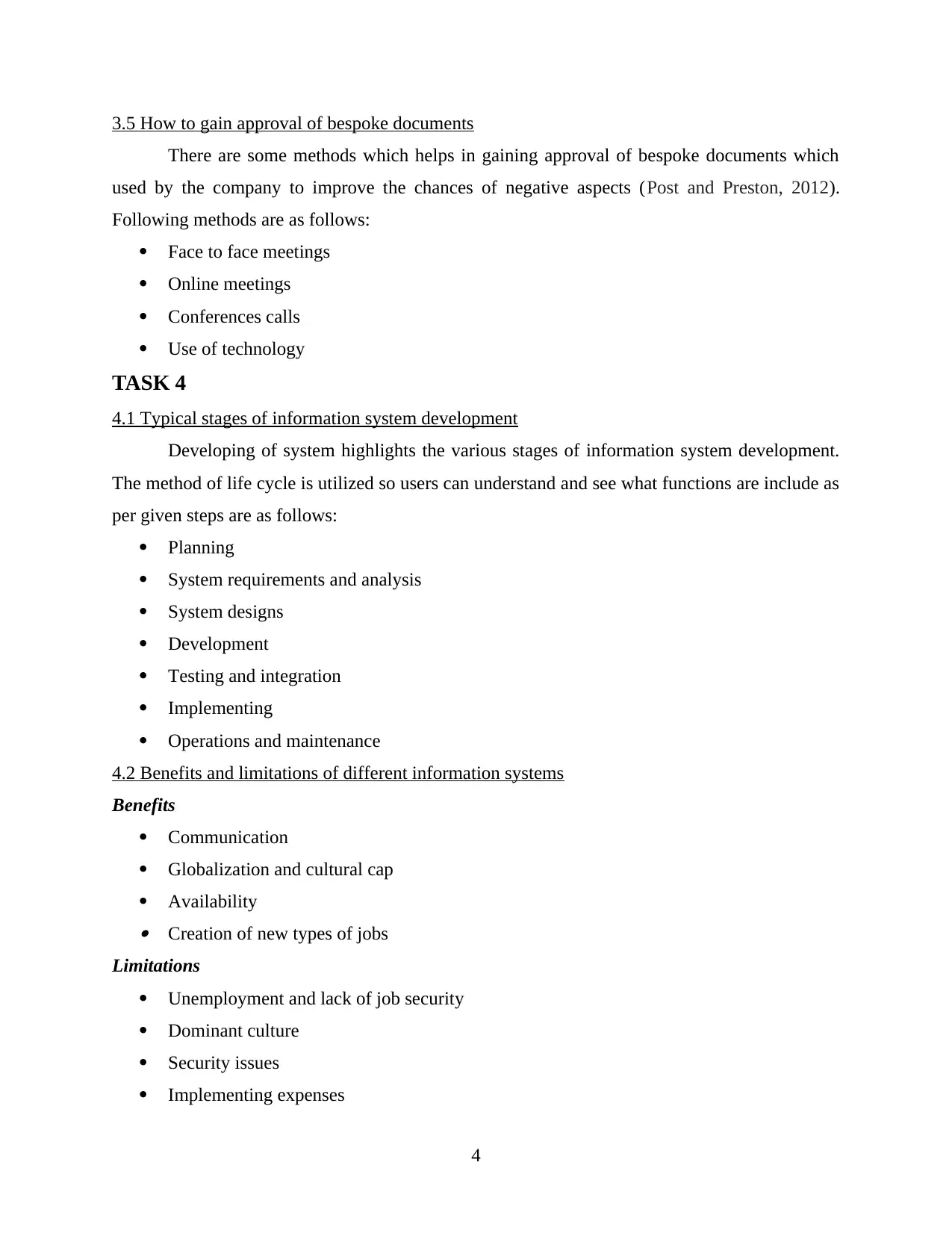
3.5 How to gain approval of bespoke documents
There are some methods which helps in gaining approval of bespoke documents which
used by the company to improve the chances of negative aspects (Post and Preston, 2012).
Following methods are as follows:
Face to face meetings
Online meetings
Conferences calls
Use of technology
TASK 4
4.1 Typical stages of information system development
Developing of system highlights the various stages of information system development.
The method of life cycle is utilized so users can understand and see what functions are include as
per given steps are as follows:
Planning
System requirements and analysis
System designs
Development
Testing and integration
Implementing
Operations and maintenance
4.2 Benefits and limitations of different information systems
Benefits
Communication
Globalization and cultural cap
Availability Creation of new types of jobs
Limitations
Unemployment and lack of job security
Dominant culture
Security issues
Implementing expenses
4
There are some methods which helps in gaining approval of bespoke documents which
used by the company to improve the chances of negative aspects (Post and Preston, 2012).
Following methods are as follows:
Face to face meetings
Online meetings
Conferences calls
Use of technology
TASK 4
4.1 Typical stages of information system development
Developing of system highlights the various stages of information system development.
The method of life cycle is utilized so users can understand and see what functions are include as
per given steps are as follows:
Planning
System requirements and analysis
System designs
Development
Testing and integration
Implementing
Operations and maintenance
4.2 Benefits and limitations of different information systems
Benefits
Communication
Globalization and cultural cap
Availability Creation of new types of jobs
Limitations
Unemployment and lack of job security
Dominant culture
Security issues
Implementing expenses
4
⊘ This is a preview!⊘
Do you want full access?
Subscribe today to unlock all pages.

Trusted by 1+ million students worldwide
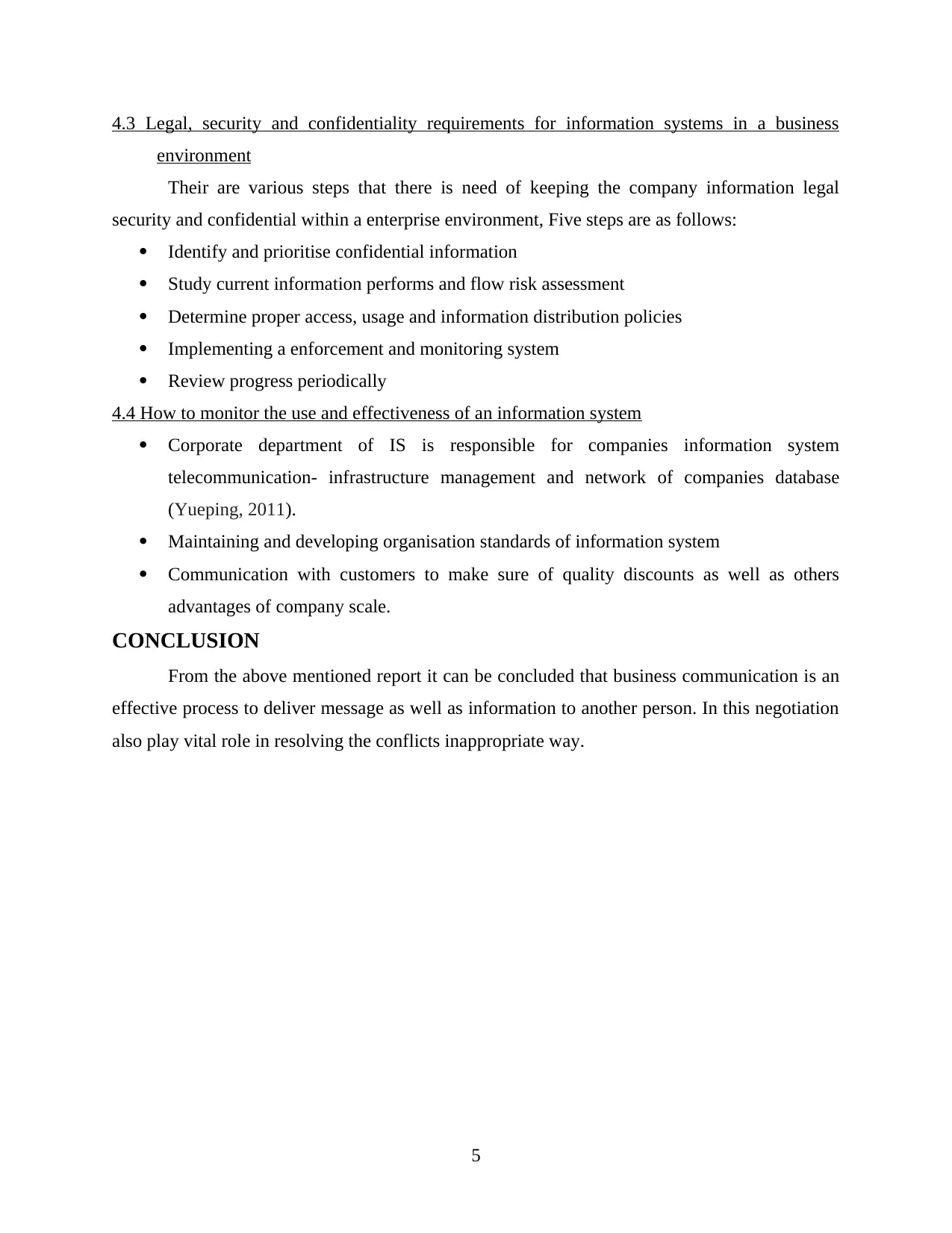
4.3 Legal, security and confidentiality requirements for information systems in a business
environment
Their are various steps that there is need of keeping the company information legal
security and confidential within a enterprise environment, Five steps are as follows:
Identify and prioritise confidential information
Study current information performs and flow risk assessment
Determine proper access, usage and information distribution policies
Implementing a enforcement and monitoring system
Review progress periodically
4.4 How to monitor the use and effectiveness of an information system
Corporate department of IS is responsible for companies information system
telecommunication- infrastructure management and network of companies database
(Yueping, 2011).
Maintaining and developing organisation standards of information system
Communication with customers to make sure of quality discounts as well as others
advantages of company scale.
CONCLUSION
From the above mentioned report it can be concluded that business communication is an
effective process to deliver message as well as information to another person. In this negotiation
also play vital role in resolving the conflicts inappropriate way.
5
environment
Their are various steps that there is need of keeping the company information legal
security and confidential within a enterprise environment, Five steps are as follows:
Identify and prioritise confidential information
Study current information performs and flow risk assessment
Determine proper access, usage and information distribution policies
Implementing a enforcement and monitoring system
Review progress periodically
4.4 How to monitor the use and effectiveness of an information system
Corporate department of IS is responsible for companies information system
telecommunication- infrastructure management and network of companies database
(Yueping, 2011).
Maintaining and developing organisation standards of information system
Communication with customers to make sure of quality discounts as well as others
advantages of company scale.
CONCLUSION
From the above mentioned report it can be concluded that business communication is an
effective process to deliver message as well as information to another person. In this negotiation
also play vital role in resolving the conflicts inappropriate way.
5
Paraphrase This Document
Need a fresh take? Get an instant paraphrase of this document with our AI Paraphraser
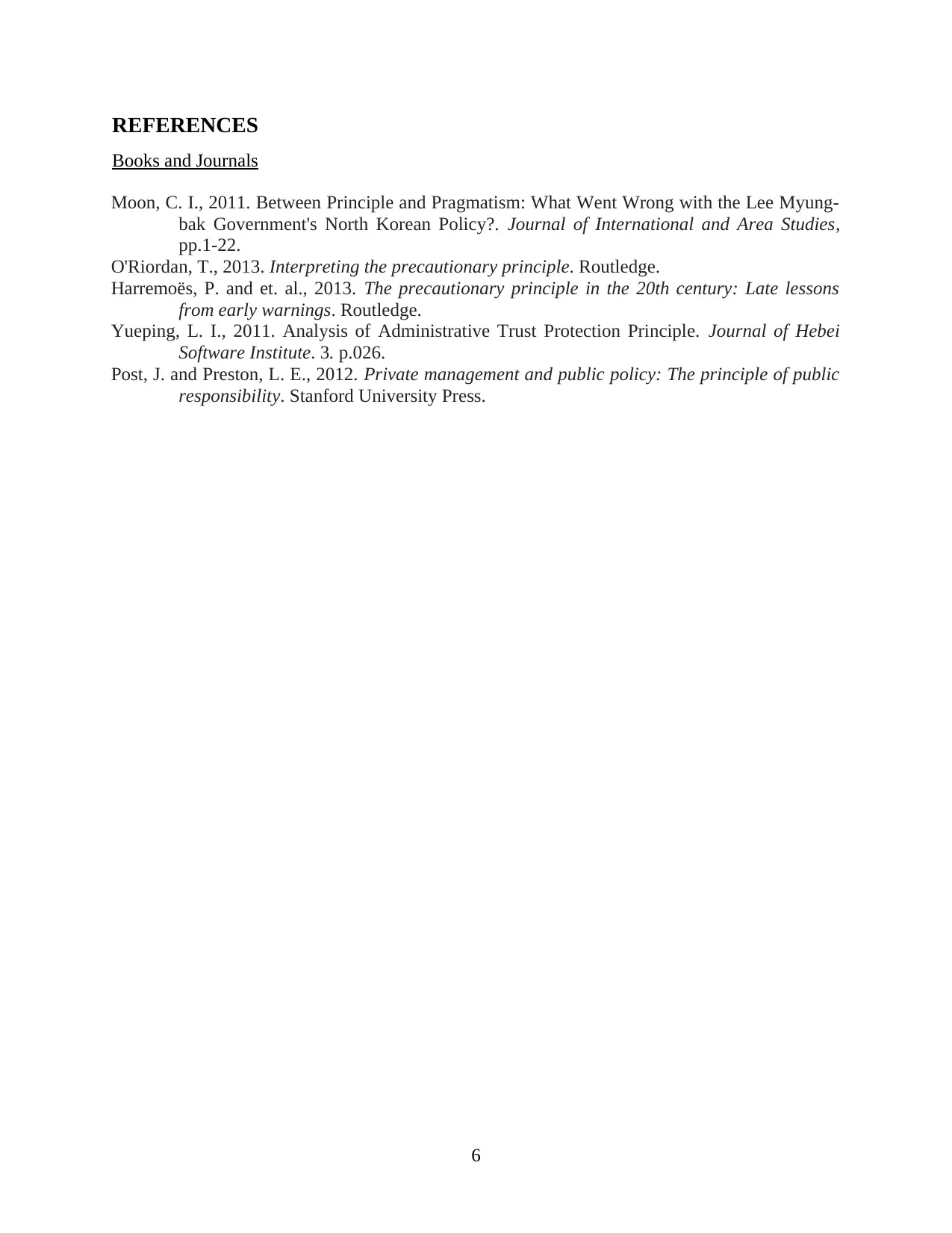
REFERENCES
Books and Journals
Moon, C. I., 2011. Between Principle and Pragmatism: What Went Wrong with the Lee Myung-
bak Government's North Korean Policy?. Journal of International and Area Studies,
pp.1-22.
O'Riordan, T., 2013. Interpreting the precautionary principle. Routledge.
Harremoës, P. and et. al., 2013. The precautionary principle in the 20th century: Late lessons
from early warnings. Routledge.
Yueping, L. I., 2011. Analysis of Administrative Trust Protection Principle. Journal of Hebei
Software Institute. 3. p.026.
Post, J. and Preston, L. E., 2012. Private management and public policy: The principle of public
responsibility. Stanford University Press.
6
Books and Journals
Moon, C. I., 2011. Between Principle and Pragmatism: What Went Wrong with the Lee Myung-
bak Government's North Korean Policy?. Journal of International and Area Studies,
pp.1-22.
O'Riordan, T., 2013. Interpreting the precautionary principle. Routledge.
Harremoës, P. and et. al., 2013. The precautionary principle in the 20th century: Late lessons
from early warnings. Routledge.
Yueping, L. I., 2011. Analysis of Administrative Trust Protection Principle. Journal of Hebei
Software Institute. 3. p.026.
Post, J. and Preston, L. E., 2012. Private management and public policy: The principle of public
responsibility. Stanford University Press.
6

7
⊘ This is a preview!⊘
Do you want full access?
Subscribe today to unlock all pages.

Trusted by 1+ million students worldwide
1 out of 9
Related Documents
Your All-in-One AI-Powered Toolkit for Academic Success.
+13062052269
info@desklib.com
Available 24*7 on WhatsApp / Email
![[object Object]](/_next/static/media/star-bottom.7253800d.svg)
Unlock your academic potential
Copyright © 2020–2025 A2Z Services. All Rights Reserved. Developed and managed by ZUCOL.





